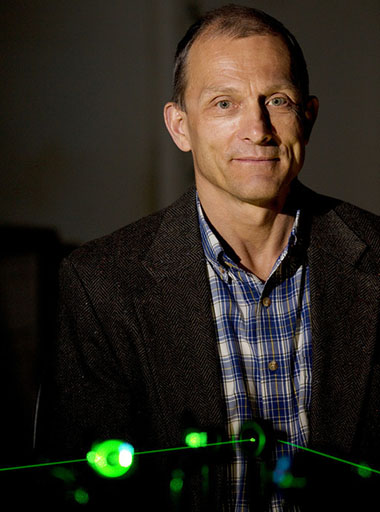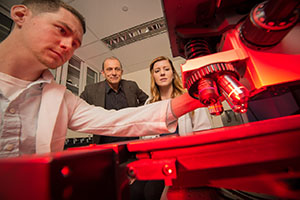Laser Focused
Forensic chemist Igor Lednev can use crime scene bloodstains to determine the age range of a suspect or victim.
 |
|
Igor Lednev, chemistry professor (photo by Paul Miller) |
ALBANY, N.Y. (July 5, 2018) -- Igor Lednev is once again making headlines for his innovative use of laser lights to help law enforcement catch criminals.
In his latest proof-of-concept study, Lednev, a professor in the Department of Chemistry at UAlbany, along with recent Ph.D. graduate Kyle Doty, were successful in using their existing forensic technology to distinguish an individual’s age range based on bloodstains.
The technology relies on Raman spectroscopy, a technique that involves shining a monochromatic light (i.e. from laser) on a sample and measuring the intensity of the scattered light. No two samples will produce the same Raman spectrum, making each measurement unique, similar to a fingerprint. The process is also nondestructive, preserving the sample for future testing.
Doty and Lednev collected blood samples from 45 individuals between the ages of less than one year to 68. Using their technique, the two were able to classify if the sample came from a newborn (younger than one year), adolescent (11-13 years old) or adult (43-68 years old), with greater than 99 percent accuracy.
The study adds to the Lednev lab’s previous research that found Raman spectra of bloodstains, coupled with advanced statistics, can differentiate race, predict the sex of an individual, and determine how long ago the stain was deposited – all without DNA profiling.
Findings were published last month in ACS Central Science.
“Our lab is working toward a single method for building a phenotype profile based on spectra collected from a blood sample. The sample can be tested at the scene of a crime and offer immediate results,” Lednev said. “We’ve been working on this for about 12 years and made significant progress since then. The next step is to develop a portable scanner that we can get into the hands of investigators.”
Chemical & Engineering News is featuring the study in the July 2 issue of its weekly trade magazine. It was also picked up by a number of other news outlets, including:
- Genome Web: How Old Were They?
- How Stuff Works: Bloodstains at Crime Scene Can Tell You Age of Victim or Suspect
- Technology Networks: Bloodstains at Crime Scenes Can Now be Used to Determine Age of Suspect
- ACS Central Science: Using bloodstains at crime scenes to determine age of a suspect or victim
- Phys org: Using bloodstains at crime scenes to determine age of a suspect or victim
- Discover Magazine: Blood at a Crime Scene Can Reveal Age of Suspect or Victim
- Forensic Connect: Using bloodstains at crime scenes to determine age of a suspect or victim
 |
|
Lednev works with recent Ph.D. graduates Claire Muro and Kyle Doty.
(Photo by Paul Miller)
|
“The extensive coverage by the media and scientific community not only provides our lab with excellent publicity, but more importantly, helps increase the reputation of UAlbany’s chemistry programs. We are seeing a significant increase in qualified applicants at both the undergraduate and graduate level during the last several years,” Lednev said.
“The synergy of successful cutting-age research and education in such an exciting area as forensics is one of the ways to make our University attractive for talented students."
The Lednev laboratory has been funded by the National Institute of Justice (NIJ) for 11 consecutive years for a total of over $3 million. His team has published over 60 articles in peer-reviewed journals over the past decade and received three US patents.
Learn more by visiting the Lednev lab website.
![]() For more news, subscribe to UAlbany's RSS headline feeds
For more news, subscribe to UAlbany's RSS headline feeds
A comprehensive public research university, the University at Albany-SUNY offers more than 120 undergraduate majors and minors and 125 master's, doctoral and graduate certificate programs. UAlbany is a leader among all New York State colleges and universities in such diverse fields as atmospheric and environmental sciences, business, education, public health,health sciences, criminal justice, emergency preparedness, engineering and applied sciences, informatics, public administration, social welfare and sociology, taught by an extensive roster of faculty experts. It also offers expanded academic and research opportunities for students through an affiliation with Albany Law School. With a curriculum enhanced by 600 study-abroad opportunities, UAlbany launches great careers.


